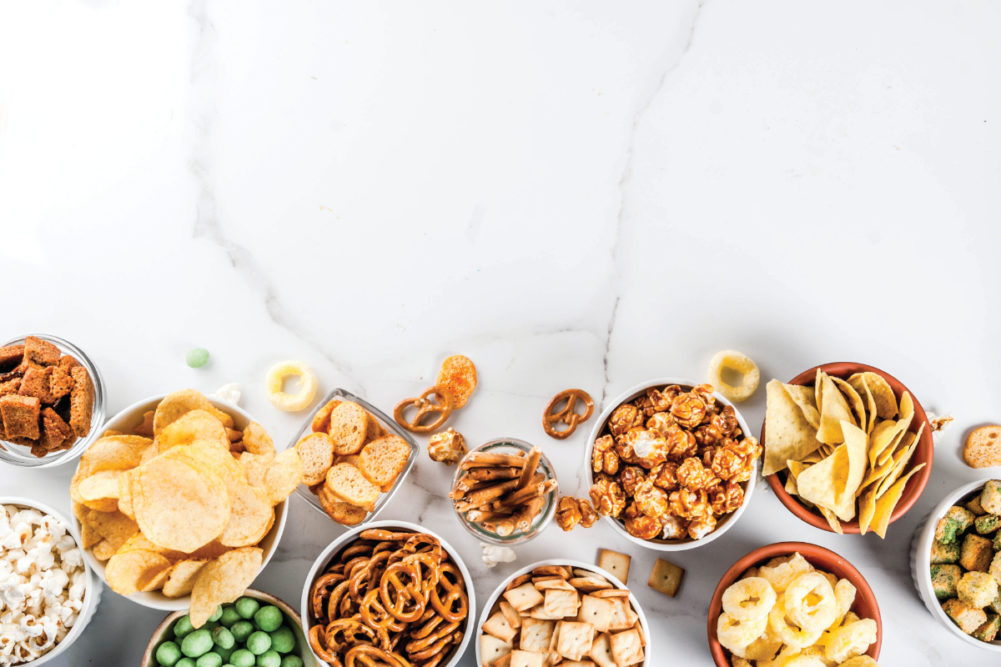KANSAS CITY, MO. - When COVID-19 sent its first shock waves through the United States, consumers were quick to throw out the healthy eating habits that were exploding pre-pandemic.
A recent study released by Port Washington, N.Y.-based NPD Group, Snack Food Behaviors in Challenging Times, found that snack food consumption increased 8% in April 2020, and snacking occasions increased by about 4% for the average consumer.
It’s also important to note that not only did the start of the pandemic expand snacking habits, it moved healthier options to the backseat as savory and sweet snacks took over the market.
“Consumers are telling us that one of the concerns that are rising during this time period is stress eating,” said Darren Seifer, NPD food and beverage industry analyst. “When you’ve got the snack bowl right in front of you, especially in these stressful times, snack foods can actually act like stress relief for many consumers. We’ve seen a lot of changes happen, and it looks like health has been on a little bit of a pause.”
In the 13 weeks leading up to June 13, data released by New York-based Nielsen showed that total salty snack consumption increased by 19.4% compared to the same timeframe in 2019 and sweet snack consumption went up by 16.1%.
Sweet and salty snacks like chips, candies and desserts can quickly add on the pounds, especially for those confined to their homes for both work and play for weeks on end. Several months into the pandemic, consumers are noticing the not-so-wanted weight gain. In May, Web MD reported that more than half a million Facebook users were engaging with terms around quarantine weight gain and coining a new term: The Quarantine 15.
““The ‘Freshman 15’ is typically paralleled with fun — you’ve gone off to school by yourself, no parents, you just want to party,” Kristin Kirkpatrick, a dietitian at the Cleveland Clinic, told Web MD. “What we’re experiencing, on the other hand, has nothing fun about it. Plus, if a substantial number of people emerge from quarantine having gained a lot of weight, it could have a significant effect on public health.”
A survey released by Philadelphia-based Nutrisystem in July found that 76% of the 2,000 American respondents to the survey reported gaining up to 16 pounds during quarantine, and 63% reported that rather than focusing on getting their ‘summer body’ in shape, they’re focusing on getting a post-quarantine body.
How consumers regulate wellness with snacking habits
Consumers manage their health and wellness through eating habits in three main approaches, said Shelley Balanko, senior vice president of Bellevue, Wash.-based The Hartman Group:
- Regulate and rationalize – this is where a lot of health and wellness perimeter food eating comes in. In this approach consumers focus on healthy eating and following specific diets.
- Intuit and interpret – still has quite a bit of fresh, perimeter food but there’s also more processed food in this mindset. In this approach consumers choose what to eat based on how it makes them feel.
- Retreat and regroup – this is the stage in which consumers decide to take a break from health and wellness eating, and avoid the typical rules they set around eating and snacking habits.
“Not considering COVID, consumers typically kind of toggle between those three approaches all the time,” Balanko said. “Early in COVID, we saw a lot of retreat and regroup and now we’re starting to see consumers go back to regulate and rationalize. They’re going to be doubling down on healthy eating now because the pandemic has shown a spotlight on the tenuous nature of our own personal health, as well as public health.”
Balanko added that consumers are going back to their commonsense and typical food philosophies, which for the last decade have been prioritizing fresh, real, less-processed perimeter foods, whether it be snacks or meal components. She predicted that in the long term, consumers are really going to be searching out snack foods that have higher nutrient density, a trend that was in motion prior to the pandemic but has been accelerated due to COVID-19.
Pre-COVID-19 trends coming back strong
Moving forward, the same direction consumers were headed before COVID-19 hit is going to become even more relevant, Balanko noted.
“Consumers just have this dawning awareness of public health concerns in particular, the health of workers associated with animal agriculture and food production,” she said. “So that is also shifting consumers toward more conscious and ethical consumption. These trends that were established pre-COVID are gaining traction because of the ripple effect of COVID.”
Convenience is another factor that has remained top of mind. While it may seem like consumers have more time on their hands while they’re spending more time at home than ever before, that hasn’t really been the case. For individuals working at home and taking care of children or other family members, the busy schedule has simply moved from out of the home to in the home. When choosing a snack, Balanko said consumers will still go for what’s easy — pre-packaged, ready-to-eat out of the container or bag items.
Other trends that will start to rise back up in the next few months are plant-based alternatives and environmentally sustainable products, Balanko predicted.
“All of those things are coming together in consumers’ minds: it’s healthier for me, healthier for others, more ethical and more sustainable.”
While these trends will spill over across the food industry, it’s important to keep them top-of-mind when deciding what snacks to market to shoppers, because nearly 50% of all eating occasions are snacks. The same values that are present when choosing meals are also present when choosing snacks.
Balanko anticipates that snacks that promote health and wellness will move back to the forefront in the long term, the longer the pandemic goes on, the more consumers are going to be seeking out foods that support their immune system. The perimeter departments have a unique opportunity to meet those needs.
Snacks made with simple ingredients
Pre-pandemic consumers were already starting to snack more often, with some of the biggest snackers snacking up to five or six times a day. The biggest snackers are usually younger consumers like Gen Z, noted Cherie Boldt, director of marketing and communications at Fairfield, NJ-based Crispy Green. Most often, those consumers are seeking healthier snacks.
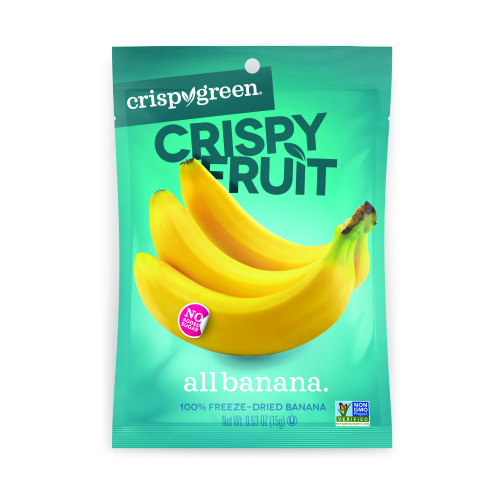 “Consumers are looking for snacking opportunities that meet their needs,” Boldt said. “They’re looking for grab-n-go, convenient snacks they take with them wherever they go or in the case of COVID, that are shelf-stable, non-GMO, Project Verified — all of the things that Crispy Green provides as there are a higher number of snackers looking more to snack in a healthier way.”
“Consumers are looking for snacking opportunities that meet their needs,” Boldt said. “They’re looking for grab-n-go, convenient snacks they take with them wherever they go or in the case of COVID, that are shelf-stable, non-GMO, Project Verified — all of the things that Crispy Green provides as there are a higher number of snackers looking more to snack in a healthier way.”
Often marketed right alongside fruit in the produce aisle, Crispy Green specializes in 100% freeze-dried fruit that snacks like a chip and has the following benefits:
- No sugar added
- Non-GMO Project Verified
- No additives or preservatives
- Gluten free
- Dairy free
- Vegan
- Peanut and tree nut free
- OU Kosher certified
- Three-year (36 months) shelf life
Crispy Green’s snack line features eight different all-fruit flavors — apple, strawberry, mango, pear, pineapple, banana, cantaloupe and tangerine. The freeze-drying process retains almost all of the nutrients of the fresh fruit, Boldt said, and with no added sugar it checks the list of what consumers are looking for right now.
“Our crispy fruit product line is 100% pure fruit, it’s just freeze-dried in such a way to give this very crispy texture. It snacks like it should,” Boldt added. “People love that texture. It’s nothing like dried fruit, it’s so light and crispy. Oftentimes people, kids especially, don’t like the texture of fruit, and this is a great way to get them to eat more fruit because they love the crispy texture.”
Like the folks at Crispy Green, Mary Mooney, president and chief executive officer of Chico, Calif.-based Bella Sun Luci, has noticed an increasing consumer interest in healthy and plant-based foods. That’s why the company recently released plant-based tomato jerky snacks that present well in the deli/prepared foods section, as well as the snack aisle of the grocery store.
Mooney started looking for a way to add a snack line to her sun-dried tomato company, after consistently hearing customers say they were interested in a sun-dried tomato they could just snack on. From there, the company began experimenting with adding different flavors to their sun-dried tomatoes and what they got in return was chewy and, with the right flavors, it snacked just like beef jerky.
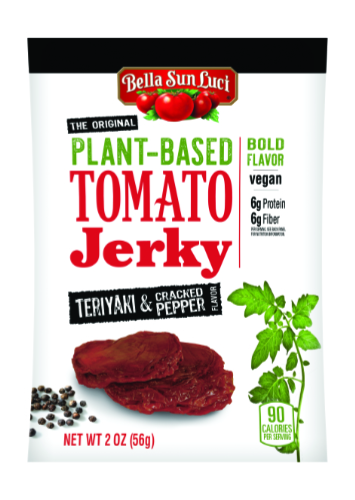
“I think consumers are looking for plant-based alternatives, but they’re also looking for healthy alternatives that aren’t a huge combination of things that come together to try to taste like something else,” Mooney said. “So, we just wanted to make a tomato and we wanted to flavor it without adding a lot of other things to the tomato.”
And that’s what Bella Sun Luci’s tomato jerky is — an 80- to 90-calorie, non-GMO, gluten-free and kosher tomato flavored with simple ingredients. The plant-based jerky comes in three flavors: teriyaki & cracked pepper, sriracha and hickory smoked. Since tomatoes are high in protein like meat, they can absorb flavors like meat can.
Making each flavor is simple, Mooney said. For the hickory smoked flavor, for example, the company simply places a sun-dried tomato in a room with hickory smoke. The sriracha flavor is simply a sun-dried tomato with sriracha added.
“We take the flavors and get them impregnated into the tomato,” Mooney said. “It doesn’t really taste like a tomato, that’s what makes it really fun.”
Currently, Bella Sun Luci is working on other flavors to add to the lineup.
Snacks made with simple ingredients go a long way with consumers if they have good flavors, said Ilana Fischer, chief executive officer of New York-based Whisps. Flavor is the company’s number one priority when it comes to their cheese crisps.
“There’s a lot of things about us that are really appealing to people shopping for ‘healthier’ options,” Fischer said. “We have people who buy us again and again, and they’re returning to us because they love the taste and the flavor. We went out to make a delicious snack, not to make a health food.”
Despite that, though, Whisps’ products have a lot of health features that match consumer interests:
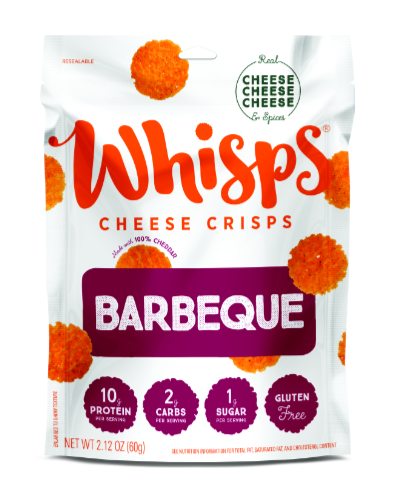
- High protein
- Low carb
- Less than three grams sugar
- Gluten free
- Good source of calcium
- Lactose free
- Keto friendly
- Made without preservatives or artificial ingredients
- Made and packed in a peanut-free facility
To make the crisps, Whisps’ cheesemakers start out with 100% cheese — whether it be parmesan, cheddar or asiago & pepper jack — and then add a blend of spices to the cheese, then they grate it and bake it, transforming the cheese into a crispy, cracker-like snack. Often sold in the deli department, Whisps offers seven different flavors: tangy ranch, nacho, parmesan, cheddar, asiago & pepper jack, barbecue and tomato basil.
Fischer added that it was a challenge to figure out how to bake the cheese in the just the right way to make it into a packaged snack with a long shelf life.
“We had to figure out how to bake cheese in a way that prevented it from becoming too oily or too crunchy or too soggy. We really put in the time to get it just right.”
“Food that’s good for you, should taste good,” Fischer added. “There’s a reason people love to eat, and food that tastes good is really enjoyable and pleasurable. The confusing thing to me is how many ingredients and chemicals companies use to make food taste good when you have something like cheese that is a very natural ingredient and has a way better flavor than anything you can get from a lab.”
Good Foods offers plant-based dips and spreads
Pleasant Prairie Wis.-based Good Foods serves up a platter of gluten-free, low-carb, low-sodium, dairy-free, high-protein and keto/paleo-friendly dips and spreads perfect for any healthy snacking occasion.
“Shoppers can coun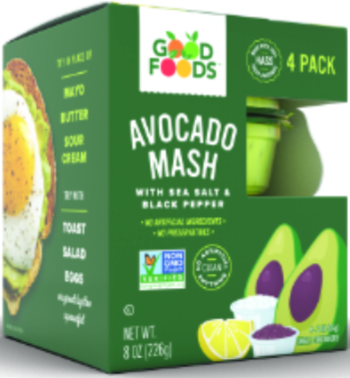 t on Good Foods to have a wide variety of products that are first and foremost delicious but also healthy, safe, affordable and packed conveniently,” said Maria Nakasone, brand manager for Good Foods. “We make great-tasting products with fresh and nutritional ingredients that have no preservatives and are safe to eat.”
t on Good Foods to have a wide variety of products that are first and foremost delicious but also healthy, safe, affordable and packed conveniently,” said Maria Nakasone, brand manager for Good Foods. “We make great-tasting products with fresh and nutritional ingredients that have no preservatives and are safe to eat.”
The company specializes in avocado-based offerings. Good Foods’ tableside chunky guacamole is only made with natural ingredients. The guacamole won best in show from Taste of Home magazine earlier this year for having the best flavor, homemade and freshness appeal, and just the right amount of avocado chunks, tomato bits and cilantro. Nakasone also highlighted the company’s Avocado Mash, which comes pre-portioned and is perfect for spreading. Both products are perfect for snack time, she said.
Good Foods also has a lineup of plant-based dips that pair well with veggies, chips, crackers and chicken. Made with fresh ingredients from a cauliflower base, the plant-based dips have no unhealthy fats and are low in carbs. Nakasone said customer favorites are Queso and Buffalo, but customers interested in diverse cuisines are also drawn to Tzatziki, Cilantro and Avocado Pesto flavors.
This story was featured in the August issue of Supermarket Perimeter. Check out the full issue here.
